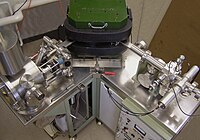
Photo from wikipedia
The advent of Multicollector ICP-MS advent inaugurated the analysis of new metal isotope systems, the so-called "non-traditional" isotopes. They are now available tools to study geochemical and ecotoxicological aspects of… Click to show full abstract
The advent of Multicollector ICP-MS advent inaugurated the analysis of new metal isotope systems, the so-called "non-traditional" isotopes. They are now available tools to study geochemical and ecotoxicological aspects of marine metal contamination and hence, to push the frontiers of our knowledge. However, such applications are still in their infancy, and an accessible state-of-the-art describing main applications, obstacles, gaps, and directions for further development was missing from the literature. This paper fills this gap and aims to encourage the marine scientific community to explore the contributions of this newly available information for the fields of chemical risk assessment, biomonitoring, and trophic transfer of metal contaminants. In the current "Anthropocene" epoch, metal contamination will continue to threaten marine aquatic ecosystems, and "non-traditional" isotopes can be a valuable tool to detect human-induced changes across time-space involving metal contaminants, and their interaction with marine biota.
Journal Title: Marine pollution bulletin
Year Published: 2022
Link to full text (if available)
Share on Social Media: Sign Up to like & get
recommendations!